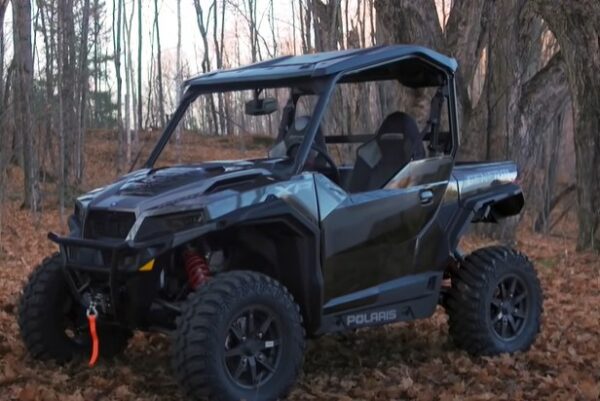The Yamaha Viking is an incredibly popular all-terrain vehicle, but like any vehicle, it can experience a few issues.
Common problems that have been reported by owners of the Viking are occasional starter or carburetor issues, as well as electrical system faults. Some rare problems are transmission problems and front-end differential failures.
The good news is that, with a few simple fixes, you can usually get your Yamaha Viking running again.
Let’s explore them in detail!
Yamaha Viking Problems

1. Overheating Issues
Overheating in the Yamaha Viking can be a very serious issue if left unchecked, as it could potentially lead to severe damage to the engine and other components.
This overheating is mostly caused by air circulation blockages within the engine compartment; dirt and debris from daily riding can build up and prevent airflow, causing the motor to overheat.
Therefore, you should regularly check the engine compartment for any build-ups and clean out any dirt or debris that may be present.
Additionally, make sure to regularly inspect the radiator cap for any signs of leakage or damage, as these issues can also cause the engine to overheat.
If either of these is detected, take your Viking to a qualified technician to have it repaired promptly.
2. CLUTCH ISSUES
Some Yamaha Viking owners have reported that they experience clutch issues with their machines.
The most common problem is a slipping clutch, which can occur when the machine is under too much strain and has to work harder than it should.
This can be caused by a number of things including faulty parts, worn-out clutches, or too much oil being used in the clutch assembly.
In order to fix this problem, the clutch needs to be inspected and repaired or replaced as needed.
Additionally, it is essential to check for any air leaks in the intake system, as this can also cause clutch issues.
3. Electric Problems
Electric problems in Yamaha Vikings can be caused by a variety of issues, such as loose connections, faulty wiring, worn-out parts, inadequate voltage, or insufficient grounding.
Loose connections can cause sparks and heat buildup that can lead to electric shorts or even fires.
Faulty wiring can also result in electrical short circuits and fires. Worn-out parts, inadequate voltage, or insufficient grounding can lead to a loss of power and cause components like the headlights, taillights, brakes, and accessories to malfunction.
In some cases, electric problems can also be caused by water damage due to failed seals or flooding in the engine compartment.
If you suspect your Yamaha Viking is having electric issues, it’s important to take it to a trusted technician or repair shop for diagnosis and repairs.
4. Starting Problem
Starting problems with Yamaha Vikings can be caused by a variety of factors.
Common culprits include an empty fuel tank, clogged fuel filter, faulty spark plug, or a dead battery.
If the vehicle does not start the key is turned on, may have to check the fuel level in order to ensure there is enough gas in the tank.
If the fuel level is adequate, then examine the spark plug and replace it if needed.
Lastly, check to ensure the battery is properly charged or needs to be replaced. Taking these steps should help resolve any starting issues with a Yamaha Viking.
5. Shifter Issues
One of the most common issues encountered by owners is a problem with the shifter.
This can manifest in several ways, such as difficulty getting the transmission out of gear, difficulty engaging a gear, or an inability to shift through all available gears.
If you’re having these issues, there are a few things you can do to try and get it back in working order.
The first thing to check is the shift lever itself. Make sure it’s properly seated in the transmission and that all of its connection points are secure and tight.
If any of them appear to be loose or worn out, replace them as soon as possible.
You should also check the shifter cable to make sure it’s not stretched or broken. If it is, replace it with a new one.
Further, inspect the shift forks for any signs of damage or wear and tear. If there are any issues, they will need to be addressed promptly.
6. Brake Problems
The Yamaha Viking is a powerful and reliable machine that can take on tough jobs. Unfortunately, due to its size and power, it can be prone to brake problems.
Brake problems can arise due to a variety of reasons such as wear and tear, improper adjustment, or inadequate maintenance.
It is vital that the brakes are inspected regularly and any issues addressed promptly to ensure the Viking remains safe and in proper working order.
Common symptoms of brake problems include grinding or squealing noises, difficulty stopping, and a feeling of instability when braking.
If any of these issues are present, it is important to have the brakes inspected and serviced as soon as possible. It is also vital to make sure that all safety components such as the brake lines and pads are in good condition.
7. Engine Problem
Engine problems with the Yamaha Viking can range from a variety of issues.
One of the most common engine problems that can arise in a Yamaha Viking is when the engine won’t start or has difficulty turning over.
This issue could be due to a variety of reasons, such as a faulty spark plug, loose or corroded connections in the ignition system, or a clogged fuel filter.
If the engine is running rough, it could be caused by an air leak in the fuel system, a faulty carburetor, worn spark plug wires, or a failed ignition coil.
Lastly, if your Yamaha Viking is producing excessive smoke and oil-burning odors, this could indicate that there is an issue with the piston rings or valve seals.
8. Transmission Problems
Transmission problems are a common issue with Yamaha Vikings and can be caused by a variety of issues.
The most common causes are a worn-out belt, a malfunctioning CVT system, or an issue with the shift actuator.
If your Yamaha Viking is experiencing jerks and lurches while shifting gears, it could indicate a problem with the transmission.
To prevent transmission problems, be sure to regularly check your Yamaha Viking’s belt for signs of wear or damage, and have the CVT system serviced as recommended by the manufacturer.
If you notice any glitches or hesitation when changing gears, it’s important to have them checked out right away before further damage occurs.
Conclusion
The Yamaha Viking is a powerful and reliable UTV that can provide years of enjoyment for its user.
However, as with any vehicle, it’s not immune to problems. In this article, we discussed some common issues associated with the Yamaha Viking, along with their causes and possible solutions.
If you encounter any of these issues while using your Yamaha Viking, be sure to take action immediately in order to avoid further damage or unnecessary costs down the road.
With proper maintenance and care, your Yamaha Viking will continue running smoothly for many miles ahead!
FAQs
Are Yamaha Vikings reliable?
No, Yamaha Vikings have had some reported reliability issues including problems with the fuel tank, brakes, and electrical systems.
Additionally, some owners have experienced engine noise and power steering issues.
Is the Yamaha Viking loud?
No, the Yamaha Viking is relatively quiet compared to other UTVs. It has a noise-dampening cabin design that makes it one of the quieter vehicles on the market.
Additionally, its muffler and engine are designed to reduce emissions and noise output for an even more pleasant riding experience.
What is the speed of the Yamaha Viking?
The top speed of the Yamaha Viking is approximately 39 mph.
Where is Yamaha Viking made?
The Yamaha Viking is made in Japan.


